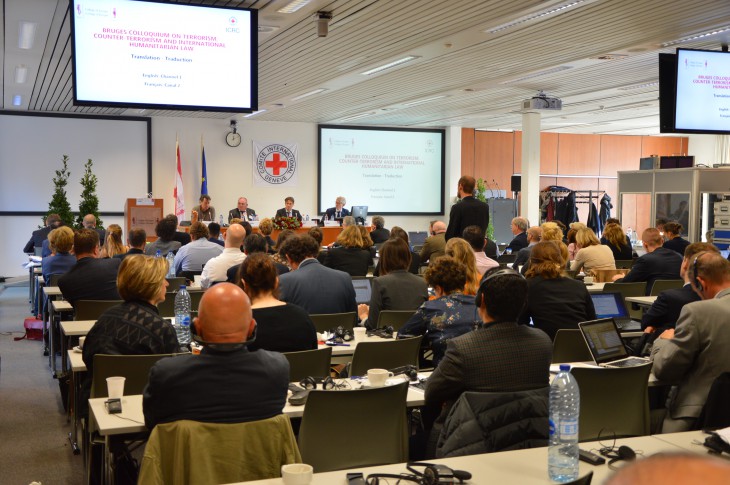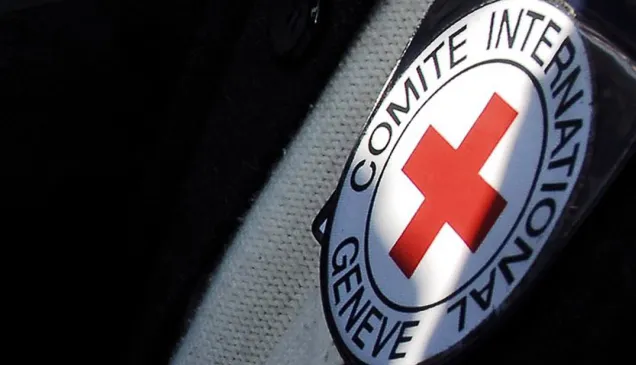Terrorism, counter-terrorism and international humanitarian law

Statement of Christine Beerli, ICRC Vice-President at the 17th edition Bruges Colloquium , 20 -21 october 2016
Terrorism is a scourge to which the international community has been striving to respond for decades. The obvious challenges it poses are not only long-lasting, but also immediate. Wherever we turn these days, across the world, we are confronted with increased risks of terrorist acts. Terrorism is a global phenomenon sometimes closely link to armed conflict; and one which the international community is increasingly facing.
Terrorism negates the fundamental principles of humanity as well as the essential principles and objectives of international humanitarian law (IHL). In this regard, the ICRC condemns acts of terrorism, irrespective of their perpetrators, be they committed in or outside an armed conflict, and is deeply distressed by their devastating impact on communities and individuals.
Indeed, every day we see the dramatic consequences of the fight between States and non-State armed groups designated as terrorist, in particular in Africa and in the Levant. Irrespective of the claimed legitimacy of this fight or the causes espoused by or attributed to those involved therein, what we observe in the field is once again the civilian population bearing the brunt of armed violence. Cities are reduced to rubble, civilians are directly attacked, humanitarian and medical personnel, transports and infrastructures are targeted and prevented from fulfilling their functions, the civilian population is deprived of supplies essential for its survival through siege warfare, humanitarian access is denied and, resulting from all of this, hundreds of thousands of people are internally displaced or have fled their country, leaving a home, a job, a plot of land, or even close relatives behind. In the absence of a political solution, compliance with IHL and the fundamental values underpinning this body of law are required more than ever, from all sides, because prohibition of acts of terrorism and other violations of the law are not just binding on non-State armed groups.

The rise of non-state armed groups resorting to acts of terrorism is a growing concern domestically but also internationally. This situation has led States and international organizations to react by tightening existing counterterrorism measures and introducing new ones. Of course, the ICRC does not challenge the necessity of States to take legitimate measures to ensure their security. Nonetheless, while taking such measures to eliminate terrorism, the safeguards protecting human life and dignity must be upheld. In the ICRC's view, the international community must be clear and firm on the need for counterterrorism activities to be conducted in full respect of the protection afforded to all individuals by international law, in particular IHL and human rights law. Such respect is in the interest of the international community, as there is today growing recognition that violations of these bodies of international law may in turn exacerbate the very phenomenon that counterterrorism purports to fight.
Neither armed conflict nor terrorism are new forms of violence. Both have existed for a long time and have, for most part, been understood to be separate phenomena, as demonstrated by the different legal frameworks that regulate them. The perception that armed conflict and terrorism differ and that their respective legal rules are distinct has radically changed since September 2001 and the subsequent launching of the so-called "global war on terrorism". Recent years have again seen the rise of non-State armed groups resorting to acts of terrorism and the subsequent engagement of a coalition of States against them. This situation has put the relationship between IHL and the legal framework governing terrorism back into the spotlight and may have even created the perception that there may be a new "global war on terrorism" involving a group or groups of unbounded geographical reach.
The recent actions taken by States against non-State armed groups designated as terrorist and the correlative counterterrorism discourse in both domestic and international fora have significantly contributed to a blurring of the lines between armed conflict and terrorism and their respective legal frameworks. This is further exacerbated by the fact that, often, counterterrorism instruments include situations of armed conflict in their scope of application. The resultant overlaps and contradictions between IHL and the legal instruments specifically designed to address terrorism is problematic. Counterterrorism norms may interfere with IHL's regulation of armed violence, notably by prohibiting conduct that is not unlawful under IHL, creating legal confusion and potentially adversely affecting some of the underlying principles of IHL. In this regard, one should carefully study the consequences of such interference and seek creative ways to ensure the integrity of IHL, thereby maintaining its rationale – which is needed more than ever in current armed conflicts.
The fight against terrorism may take various forms, including armed conflict. Determining when IHL applies to particular counterterrorism activities is not an easy enterprise. Not only because some States may tend to deny the applicability of IHL on the basis that non-State armed groups designated as terrorist organizations cannot be considered party to an armed conflict. How, when and where IHL applies to counterterrorism activities still raises important legal questions.
First of all, it is important to recall that any use of force against non-state armed groups designated as terrorist – or against members and affiliates thereof – is not necessarily synonymous with a situation of armed conflict governed by IHL. When armed force is used, only the facts on the ground are relevant for determining the legal classification of a situation of violence. Some situations may be classified as international armed conflicts, others as non-international armed conflicts, while various acts of violence may fall outside any armed conflict due to lack of requisite nexus. In the ICRC's view, this is also true for the fight against terrorism.
Another crucial question relating to IHL applicability is whether non-state armed groups designated as terrorist fulfil the organization criterion for classifying a situation as a non-international armed conflict. This is all the more difficult in view of the myriad of fluid, multiplying and fragmenting armed groups that frequently take part in the fighting. Often, their structure is difficult to understand. In some cases, some form of leadership structure emerges at some point, claiming to unite different armed groups, often based on pledges of allegiances. This raises the question of what link needs to exist between different armed groups in order to consider formerly distinct entities as one party to an armed conflict. The same question also emerges with regard to different groups that join forces transnationally, such as different armed groups pledging allegiance to the Islamic State group or to Al Qaida.
The spillover of conflicts into neighboring countries, their geographical expanse and their regionalization also appear to have become distinctive features of many contemporary armed conflicts involving non-state armed groups designated as terrorist. The transnational nature of such armed conflict involving a non-state armed group capable of operating in various countries – even non-contiguous ones – directly raises the question of IHL's territorial reach. This is still a much-debated area of the law – in particular when it comes to the applicability of IHL for military operations in the territory of non-belligerent States – that will certainly benefit from your insights.
IHL has been sometimes described – wrongly in the ICRC's view – as a set of rules which hinders the efforts of States to efficiently address their security concerns and fails to provide adequate tools to deal with non-state armed groups designated as terrorist. I am confident that we will be able to dispel some misconceptions in this regard and highlight the fact that, in situations of armed conflict, IHL should not be considered as an obstacle to the fight against terrorism. On the contrary, IHL can be a powerful tool at States' disposal while still providing important protections – complemented by human rights law – for those affected by the armed conflict between States against non-State armed groups designated as terrorist. This added value of IHL is significant in the fields of the use of force and detention.
The phenomenon of the so-called "foreign fighters" – nationals of one country who travel abroad to fight alongside a non-State armed group in the territory of another State – has increased exponentially over the past few years. In order to quell the threats emanating from foreign fighters, States - in particular within the framework of the UN Security Council - have taken a variety of measures, including the use of force, detention (on terrorism charges, among others), and travel bans.
While most of the measures taken to prevent individuals from joining non-State armed groups or to mitigate the threat they may pose upon return are of a law enforcement nature, the applicability of IHL, where appropriate, should not be overlooked. However, so far, little attention has been paid to how IHL deals with the phenomenon of foreign fighters.
The concept of a "foreign fighter" is not a term of art in IHL. The general applicability of IHL to a situation of violence in which such fighters may be engaged does not depend on the nationality of those fighting. It depends only on the facts on the ground and on the fulfilment of certain legal conditions stemming from the relevant norms of IHL, in particular common Articles 2 and 3 of the Geneva Conventions. In other words, in situations of armed conflict, IHL will govern the actions of foreign fighters, as well as any actions against them by parties to that conflict, when such actions have a nexus to the armed conflict concerned.
In this regard, it is important to underline that foreign fighters detained in relation to an armed conflict to which the detaining authorities are party must benefit from the protections afforded by the applicable IHL rules, irrespective of the domestic laws that also govern their detention. Unfortunately, States dealing with the phenomenon of foreign fighters tend to shy away from recognizing the applicability of IHL to their detention. Our discussions will certainly allow us to understand why this is so and to clear up the misapprehension that IHL would not allow States to prosecute foreign fighters – a misapprehension which, in the ICRC's views, has no legal basis under IHL.
For nearly a decade the idea that the risk of radicalization potentially leading to violent actions should be addressed though social prevention programs has significantly progressed. Many States are developing and implementing various domestic plans to address the root causes of this phenomenon. These programs are now usually referred as preventing or countering violent extremism (P/CVE). States' understanding that "terrorism" must be fought through more than simply military or hard security means is in fact not a new avenue. It is mimicking years of counter-insurgency strategies and stabilization concepts implemented in conflict affected countries. Yet such P/CVE model has gained considerable ground amongst countries confronted to so-called home grown terrorism and the re-occurrence of violent actions against their respective population. In this political context, international organizations, the RC/RC Movement and various civil society actors are being asked to partner with states and support this movement through their existing or specially design programs.
The ICRC does not question the merit of these initiatives which may ultimately contribute to limit the risks of violations and abuses. However, while recognizing the general purpose of P/CVE concept as expressed in the recent UN plan of action that is to address the root cause of extreme violence, one should not underestimate its potential adverse effects on the existing legal protection frameworks. There may be also a risk that humanitarian organizations associated with CVE/PVE programs be seen by some States and non-State actors as politically motivated and therefore incapable to carry out a neutral, independent and impartial humanitarian action.
Within the framework of counterterrorism measures, efforts to curb and criminalize all possible direct and indirect support to so-called terrorist organizations have led to increased control and restraint on all activities, including humanitarian activities, that could in any way be seen as providing support to non-State armed groups or individuals designated as terrorists. Consequently, there is a significant risk that such measures, in particular criminal legislation, may further reduce the humanitarian space which the ICRC and other impartial humanitarian organizations need in order to carry out their neutral, independent and impartial activities.
Since 2011, the ICRC has on various occasions shared its concerns that such counter-terrorism measures have the potential to criminalize a range of humanitarian actors and their personnel, and may create obstacles to the funding of humanitarian activities. The unqualified prohibition of acts of "material support," "services" and "assistance to" or "association with" terrorist organizations found in certain criminal laws could, in practice, result in the criminalization of the core activities of impartial humanitarian organizations, and their personnel, that are endeavoring to meet the needs of victims of armed conflicts or situations of violence below the threshold of armed conflict.
In addition, the potential criminalization of humanitarian engagement with non-State armed groups designated as "terrorist organizations" and of humanitarian activities carried out in areas controlled by these groups may be said to reflect a non-acceptance of the notion of neutral, independent and impartial humanitarian action – a notion which the ICRC strives to promote in its operational work in the field.
The ICRC has deployed significant efforts to persuade States to stop legislating against principles they have supported and endorsed through IHL treaties, as well as to ensure that the new legal frameworks being developed as part of counterterrorism strategies do not challenge principled humanitarian action. So far, our work on this crucial issue was not as successful as we had expected, but the ICRC is convinced that stakeholders will understand the necessity to harmonize their policies and legal obligations across the humanitarian and counterterrorism realms.
For more information on the Bruges colloquium, please consult the following website of the College of Europe : http://www.coe-icrc.eu/en



